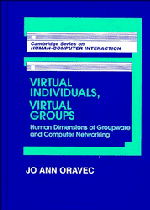Book contents
- Frontmatter
- Contents
- Dedication
- Overview
- Introduction
- 1 Evolution of computer application genres: Groupware and other network-based system applications
- 2 On the infinite variety of virtual entities
- 3 The shape of groups to come: Efforts to define, label, explain, and model collaborative activity
- 4 Shared resources and spaces: Lessons from the use of desks, tables, whiteboards, office settings, and video
- 5 Cultural objects and technological dreams: Dependence, autonomy, and intellectual augmentation
- 6 Privacy, anonymity, and agency: Applications of computer networking and the development of social analogues
- 7 Toward a genre-responsive design approach for computing applications
- Bibliography
- Author index
- Subject index
Introduction
Published online by Cambridge University Press: 05 August 2011
- Frontmatter
- Contents
- Dedication
- Overview
- Introduction
- 1 Evolution of computer application genres: Groupware and other network-based system applications
- 2 On the infinite variety of virtual entities
- 3 The shape of groups to come: Efforts to define, label, explain, and model collaborative activity
- 4 Shared resources and spaces: Lessons from the use of desks, tables, whiteboards, office settings, and video
- 5 Cultural objects and technological dreams: Dependence, autonomy, and intellectual augmentation
- 6 Privacy, anonymity, and agency: Applications of computer networking and the development of social analogues
- 7 Toward a genre-responsive design approach for computing applications
- Bibliography
- Author index
- Subject index
Summary
The work of a crowd is always inferior, whatever its nature, to that of an isolated individual.
Gustave LeBon (1895/1960, p. 200)The release of productivity is the product of cooperatively organized intelligence.
Dewey and Tufts (1939, p. 446)“Collaboration” and “cooperation” among individuals – the harnessing of people's skills and talents to conduct projects, make decisions, and create new ideas – are notions that are both commonplace and elusive. The contradiction between the two epigraphs underscores the fact that controversies concerning the value of collaboration are not new. We have all participated in meetings and team projects, in informal exchanges as well as structured games, but these activities remain only vaguely understood and nearly impossible to predict and control with any precision. Our modes of individual and group expression (our “virtual individuals” and “virtual groups”) are intimately linked with the technologies that support group interaction – technologies that have undergone dramatic change in the past decades.
Network-based computer applications designed to support joint efforts (“computer-supported cooperative work,” or CSCW, applications) have both staunch supporters and fierce critics. Promoters have characterized these systems as “coaches” and “educators” (Winograd and Flores, 1986); critics, in turn, have labeled the same systems as “oppressors” and “masters” with a “digitized whip” (Dvorak and Seymour, 1988). The terms “groupware” and “workgroup computing” can be found in many computing, management, and social science publications, along with words of high praise, condemnation, or ennui. Virtual reality (VR) applications have been incorporated into some CSCW initiatives, sometimes compounding confusion about the systems and further steepening the learning curve.
- Type
- Chapter
- Information
- Virtual Individuals, Virtual GroupsHuman Dimensions of Groupware and Computer Networking, pp. 1 - 15Publisher: Cambridge University PressPrint publication year: 1996



